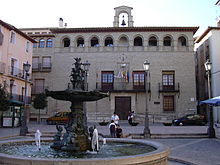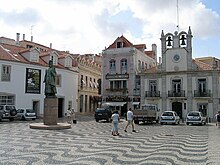Bell gable



A bell gable ( French clocher-mur ; English bell-gable , Spanish espadaña , Catalan espadanya ) is an element of church architecture in southern Europe and in the former Spanish-Portuguese colonial empire. It is used in church buildings - similar to a roof turret - as an inexpensive replacement for a bell tower or belfry .
Modern, functionally comparable, but mostly free-standing parts of the building that were not erected above the gable are called bell carriers.
history
Ancient or early medieval forerunners of the bell gable are not known; its origin is probably only in the late 11th or early 12th century. While they are common in Romanesque architecture , they almost completely disappeared in Gothic , but experienced a revival in simple, mostly rural church buildings in the Renaissance and Baroque periods .
Dating bell gables is difficult because in many cases they were added or modernized afterwards.
function
A bell gable has arched openings in which the mostly small church bells are suspended freely. They were usually rung from the outside with long ropes; some constructions also made it possible to ring the bell from within. Some bell gables should probably also or mainly be ornamental gables.
to form
There are simple, double and multi-storey or broad bell gables - the latter are also called "bell arcades". In the north of Catalonia there are even some crenellated bell gables that are open at the top (e.g. the churches of Sant Vicenç de Vilamalla or Sant Martí d ' Empúries ). While the inner sides of the arches are mostly undecorated, the outer sides sometimes have decorations in the form of small obelisks , spheres, volutes , etc.
placement
Bell gables mostly tower above the western gable wall opposite the apse of a church ; in rare cases (e.g. in some churches in southwest France or in northern Spain) the bell gable is outside above the choir or triumphal arch between the nave and apse (e.g. Iglesia San Salvador in Tirgo ). Long bell gables are also possible (e.g. Iglesia San Martin in Briviesca or Ermita Santo Cristo de San Sebastián in Coruña del Conde ). In the baroque era, a few bell gables were integrated into the overall structure (see Pedro de Ribera ); others stand free next to the church ("bell wall" or Kodonostasion ). A few important churches even have two bell gables. The church of Sant Bartomeu in Sóller , Mallorca , received a diadem-like, functionless bell gable when the facade was redesigned in 1904 .
Geographical distribution
Typical bell gables can be found almost exclusively on churches in the northern Mediterranean area; in Central and Northern Europe they are rather rare or their form is often alienated. With the Spanish conquistadors and missionaries they also came to the Canary Islands as well as to North, Central and South America and the Philippines . The St. Johannes Nepomuk Church in Altenberge-Hansell (North Rhine-Westphalia) has one of the few bell gables outside of the distribution area described .
Examples
- Bell gable
San Sadurni , Biescas , Valle de Bardají , Aragón (12th century)
Prieuré de Marcevol , Roussillon (mid-12th century)
San Salvador de Cantamuda , Castile (around 1200)
Ermita San Miguel , Santo Toribio de Liébana , Cantabria (13th century)
Santa María de la Oliva , Villaviciosa , Asturias (originally 13th century)
Notre-Dame-de-l'Assomption in Villefranche-de-Lauragais , Lauragais (around 1360)
Saint-André in Gotein-Libarrenx , Basque Country (around 1500)
San Millan in Villamaderne , Basque Country (around 1600)
Portal of the chapel of the pawnshop and poor house of Madrid ( Monte de Piedad ; 1733)
Ex-convent of San Juan Bautista in Tlayacapan , Morelos , Mexico (16th century)
Templo del Calvario in Chiapa de Corzo , Chiapas , Mexico (17th and 19th centuries)
St. Johannes Nepomuk in Altenberge-Hansell , North Rhine-Westphalia (1765)
St. Bartholomew , Sóller , Mallorca (1904)
Église Saint-Hilaire in Cros-de-Ronesque , Auvergne (16th century)
Iglesia de San Pedro in Ribafrecha , La Rioja (around 2000)
Modern variant at St. Albertus Magnus in Ottobrunn (1977)


Town halls
Bell gables are extremely rare on secular buildings (e.g. town halls); however, there are a few historical examples in Spain, Portugal, and Central and South America. The ringing of bells served here to attract attention (e.g. during fires, political meetings, public announcements, receiving guests of honor, etc.). In addition, many secular councilors found themselves in a certain competitive position with the church authorities.
Houses
In the coastal cities of Central Europe ( Flanders , Holland , Friesland , Baltic Sea region ), gables with a bell-shaped silhouette on representative urban and bourgeois buildings of the Baroque period are also referred to as "bell gables". However, they have nothing in common with the bell gables in the narrower sense.


















